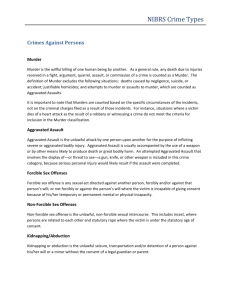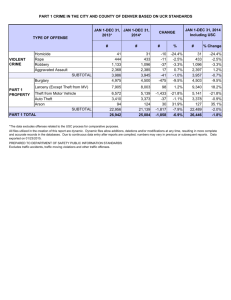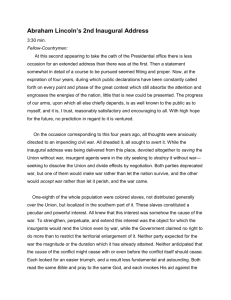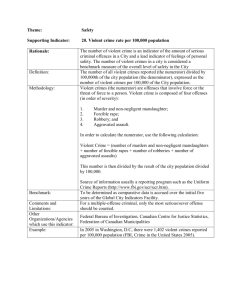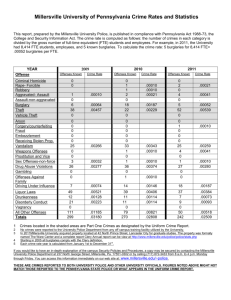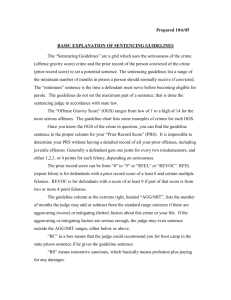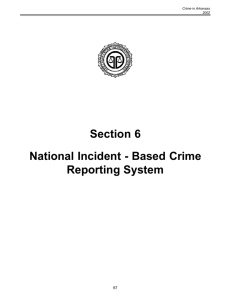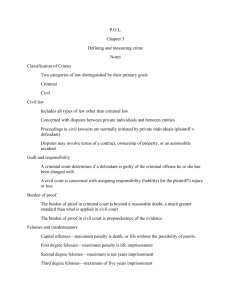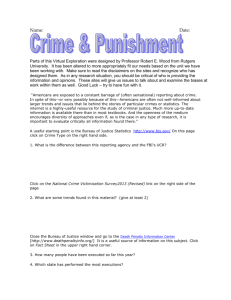National Incident-Based Reporting System (NIBRS) versus
advertisement
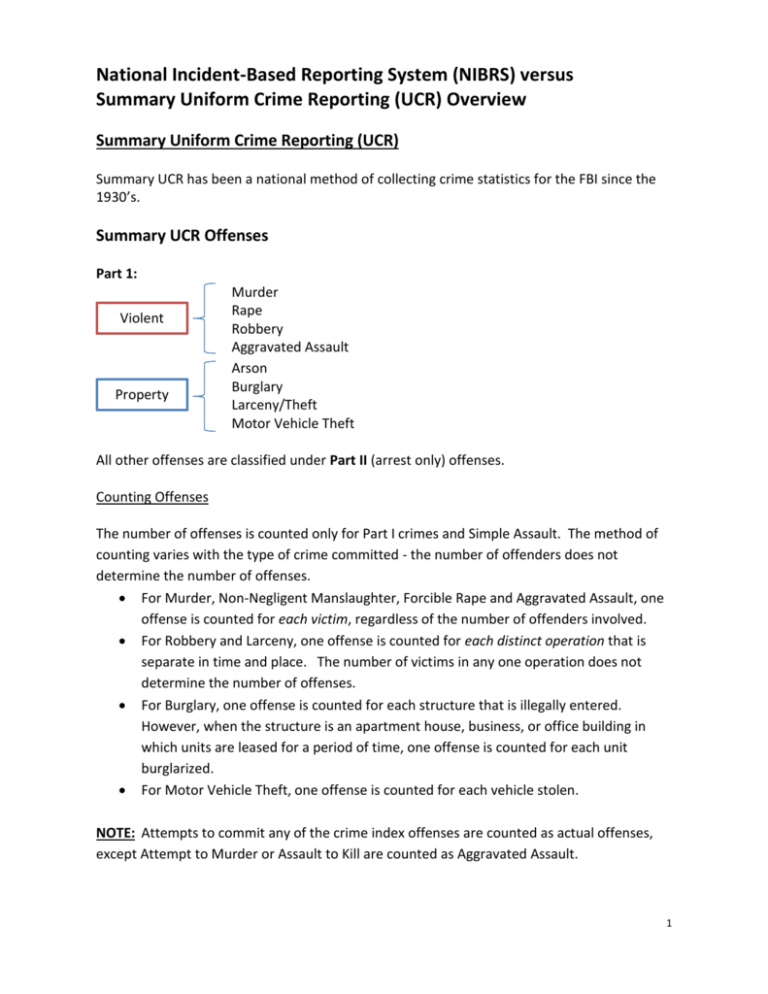
National Incident-Based Reporting System (NIBRS) versus Summary Uniform Crime Reporting (UCR) Overview Summary Uniform Crime Reporting (UCR) Summary UCR has been a national method of collecting crime statistics for the FBI since the 1930’s. Summary UCR Offenses Part 1: Violent Property Murder Rape Robbery Aggravated Assault Arson Burglary Larceny/Theft Motor Vehicle Theft All other offenses are classified under Part II (arrest only) offenses. Counting Offenses The number of offenses is counted only for Part I crimes and Simple Assault. The method of counting varies with the type of crime committed - the number of offenders does not determine the number of offenses. For Murder, Non-Negligent Manslaughter, Forcible Rape and Aggravated Assault, one offense is counted for each victim, regardless of the number of offenders involved. For Robbery and Larceny, one offense is counted for each distinct operation that is separate in time and place. The number of victims in any one operation does not determine the number of offenses. For Burglary, one offense is counted for each structure that is illegally entered. However, when the structure is an apartment house, business, or office building in which units are leased for a period of time, one offense is counted for each unit burglarized. For Motor Vehicle Theft, one offense is counted for each vehicle stolen. NOTE: Attempts to commit any of the crime index offenses are counted as actual offenses, except Attempt to Murder or Assault to Kill are counted as Aggravated Assault. 1 In Summary UCR, for multiple offenses that occur in one crime incident, only the most serious offense is counted. This is known as the hierarchy rule. Part I crimes are ranked according to seriousness and appear in order from most serious to least serious crimes. NOTE: 1. Arson is an exception to the above rule and is counted separately from other offenses. 2. The number of offenses is not reported for Part II offenses. Summary UCR Hierarchy Rule 1. Criminal Homicide a. Murder and Non-negligent Manslaughter b. Manslaughter by Negligence 2. Forcible Rape a. Rape by Force b. Attempts to Commit Forcible Rape 3. Robbery a. Firearm b. Knife or Cutting Instrument c. Other Dangerous Weapon d. Strong-arm—Hands, Fists, Feet, etc. 4. Aggravated Assault a. Firearm b. Knife or Cutting Instrument c. Other Dangerous Weapon d. Hands, Fists, Feet, etc.—Aggravated Injury 5. Burglary a. Forcible Entry b. Unlawful Entry—No Force c. Attempted Forcible Entry 6. Larceny-theft (except motor vehicle theft) 7. Motor Vehicle Theft a. Autos b. Trucks and Buses c. Other Vehicles 8. Arson a. Structural b. Mobile c. Other 2 National Incident-Based Reporting System (NIBRS) NIBRS UCR was developed in the 1980’s to replace the Summary UCR method of collecting crime statistics for the FBI. In December 2006, Washington State was certified by the FBI to officially collect and submit NIBRS data. NIBRS Offenses Group A: Aggravated Assault Arson Bribery Burglary Credit Card/ATM Fraud Counterfeiting/Forgery Drug Equipment Violations Drug/Narcotic Violations Embezzlement Extortion/Blackmail Forcible Fondling Forcible Rape Forcible Sodomy Fraud through Swindle/Confidence Game Gambling Offenses - Betting/Wagering Gambling Equipment Violations Human Trafficking Offenses Impersonation Incest Intimidation Involuntary Servitude Group B (Arrests): Bad Checks Curfew/Loitering/Vagrancy Violations Disorderly Conduct Driving Under the Influence Drunkenness Kidnapping/Abduction Larceny/Theft Manslaughter Motor Vehicle Theft Murder and Non-Negligent Manslaughter Pornography/Obscene Material Stolen Property - Possess/Receive Prostitution Prostitution - Assisting/Promoting Prostitution - Purchasing Robbery Sexual Assault w/Object Simple Assault Sports Tampering Statutory Rape Destruction/Damage/Vandalism of Prop Violate No Contact/Protection Order (WA) Weapon Law Violation Welfare Fraud Wire Fraud Family Offenses - Non-Violent Liquor Law Violations Peeping Tom Trespass of Real Property All Other Offenses NIBRS Offense Categories Crimes Against Persons Victims are always individuals Count one offense for each victim 3 Crimes Against Property Object of the crime is to obtain money, property, or other benefit Count one offense for each distinct operation with the exception of Motor Vehicle Theft where one offense is counted for each stolen vehicle Crimes Against Society Represent society’s prohibition against engaging in certain types of activity; they are typically victimless crimes in which property is not the object Count one offense for each crime against society Crime Index In the past, the Crime Index was used as a basic measure for comparing the extent of crime among cities, counties, and states of similar size. The index was simply the total number of certain offenses that occurred in a given area in a given calendar period. The offenses used in the Crime Index were the Summary UCR offenses of Murder, Forcible Rape, Robbery, Aggravated Assault, Burglary, Larceny-Theft, Motor Vehicle Theft, and Arson. In June 2004, the FBI Criminal Justice Information Services Division Advisory Policy Board approved discontinuing the used of the Crime Index in the FBI UCR Program and its publications. The Crime In Washington 2012 is the first NIBRS-oriented annual report we are not converting NIBRS data into Summary UCR data for the purposes of statewide statistical comparison; therefore, beginning with the 2012 annual report, Washington State no longer uses the “term” Crime Index as a measure to depict incidence of crime. Crime Rate A crime rate is based on a specific crime category, such as Crimes Against Persons, Crimes Against Property, or Crimes Against Society, or specific crime grouping, such as violent crimes. The category or grouping is adjusted for variances in population by indicating the number of offenses for each 1,000 persons (other base population increments may be used such as the number of offenses per 100,000). This means that comparisons may be made among several areas with different populations or within one area with different populations over a period of time, without the information being biased by population differences. For most general comparisons, the crime rate is probably the most accurate to use. To calculate the crime rate, first divide the population of the area by 1,000, and divide the crime category or grouping by that answer. For example, if a city has a population of 273,000 and a crime category of 21,257 the calculations would be: 1. 2. 273,000 divided by 1,000 = 273.0 21,257 divided by 273.0 = 77.86 Thus, although a city's crime category is 21,257, its crime rate (the number of crimes for each 1,000 people) is 77.86. 4 Current NIBRS Conversion Status As of October 2013, 218 of 239 reporting agencies are NIBRS-certified; representing 91% of agencies and 70% of population The remaining 21 agencies have requested extensions due to records management system (RMS) upgrades. County 17 31 31 32 32 32 34 34 34 34 37 10 Granted Extensions Pop County Kent PD (7/1/13) - testing Edmonds PD - testing Granite Falls PD - preparing Spokane SO (12/31/13) Spokane PD (12/31/13) Spokane Valley PD (12/31/13) Lacey PD (7/31/13) - testing Olympia PD (7/31/13) - testing Tumwater PD (7/31/13) - testing Yelm PD (7/31/13) - preparing Whatcom SO (12/31/13) - preparing 2% 1% 17 17 31 31 31 31 31 31 31 31 2% 3% 1% 1% 1% May Need Longer Extensions King SO (incl 10 contracts) Bellevue PD Snohomish SO Arlington PD Everett PD Lynnwood PD Marysville PD Mukilteo PD Stanwood PD Sultan PD Pop 8% 2% 4% 1% 1% 1% As published in the 2012 Crime In Washington report, thirteen (13) agencies submitted via both Summary UCR and NIBRS in 2012: Buckley PD Carnation PD Des Moines PD Duvall PD Enumclaw PD Hoquiam PD Mercer Island PD Ocean Shores PD Prosser PD University of WA PD Walla Walla PD Wenatchee PD Yakima County SO Thirty-five (35) agencies reported Summary UCR only in 2012: King County SO Auburn PD Bellevue PD Burien PD* Covington PD* Kenmore PD* Kent PD Maple Valley PD* Newcastle PD* North Bend PD* Sammamish PD* SeaTac PD* Shoreline PD* Woodinville PD* Fife PD Milton PD Snohomish County SO Arlington PD Edmonds PD Everett PD Granite Falls PD Lake Stevens PD Lynnwood PD Marysville PD Mukilteo PD Stanwood PD Sultan PD Spokane County SO Spokane PD Spokane Valley PD Lacey PD Olympia PD Tumwater PD Yelm PD Whatcom County SO *Contract police agencies with King County SO 5 Issues for Data Research and Analysis 2011 was the last year WASPC “converted” NIBRS data to Summary UCR for display and comparison. Not all agencies have converted to NIBRS yet (9% of agencies representing 30% of population still reporting Summary). NIBRS data cannot be compared to Summary data due to the disparate methods of reporting - including counting offenses and the hierarchy rule. In NIBRS, there are no “fixed” statistics because law enforcement agencies update their incidents as new information becomes available. Arrest data should not be compared to previous years' data due to a law enforcement agency conversion from Summary UCR to NIBRS and the inconsistent reporting in the “All Other Offenses” category. Specifically, a warrant arrest may or may not have been submitted under the NIBRS “All Other Offenses” category because a duplicate incident number cannot be submitted. A Data Report Option The WASPC Criminal Justice Information Support (CJIS) Department can provide “ad hoc” reports based on defined criteria. Rather than Summary “Part 1”, NIBRS has “Group A” offenses and within the Group A offenses, CJIS can provide a customized report based on offenses chosen. For example, Summary UCR Part 1 Violent Crimes are defined as Aggravated Assault, Murder, Rape, and Robbery. If a report on NIBRS Group A “Violent” Offenses is requested, CJIS can provide data from agencies for incidents of Aggravated Assault, Sexual Assault w/Object, Forcible Fondling, Forcible Rape, Forcible Sodomy, Murder and Non-Negligent Manslaughter, and Robbery. CJIS can provide crime rates (based on population) and, depending on when an agency implemented NIBRS, there may be multiple year comparisons available. 6
